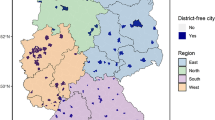Abstract
Purpose
Oropharyngeal cancer is estimated to continue to increase in the next decades. Prevention strategies and knowing the current situation of knowledge and concern of the population about this disease is necessary. Infodemiology is valuable to monitor health information-seeking behaviour trends and epidemiology. The objective of this study is to analyze the use and evolution, through Google trends as a source of information, of internet-based information-seeking behaviour related to the oropharyngeal cancer in Spain and related to mass media stories.
Methods
Using Google Trends, the terms “throat cancer’, “HPV”, “laryngeal cancer”, “tonsil cancer” and “oral cancer”. The searches volume and trend were analyzed using a Jointpoint regression method from January 2009 to July 2019.
Results
The most searched term was “HPV”, with a search volume index of 61, followed by “throat cancer” (SVI = 25). The trend of the term “HPV” increased 6.1% annually (p < 0.000), with a linear correlation of both terms of 0.52 (p < 0.000). The greatest number of searches was carried out in the north of Spain, the most repeated query being “oral sex AND cancer”. A correlation between the news in the media and the increase in the volume of searches for the terms was found.
Conclusion
Any news stories, new interventions or aetiology related to oropharyngeal cancer can manifest as an increase in information-seeking behaviours for “throat cancer” on Google. Understanding healthcare information-seeking behaviour is essential in order to control and plan the quality of knowledge provided by health organisations, advocacy groups and health professionals regarding head and neck cancers.



Similar content being viewed by others
References
Al Nuaimi E, Al Neyadi H, Mohamed N, Al-Jaroodi J (2015) Applications of big data to smart cities. J Internet Serv Appl 6:25. https://doi.org/10.1186/s13174-015-0041-5
Gandomi A, Haider M (2015) Beyond the hype: big data concepts, methods, and analytics. Int J Inf Manag 35:137–144. https://doi.org/10.1016/j.ijinfomgt.2014.10.007
Yoo C, Ramirez L, Liuzzi J (2014) Big data analysis using modern statistical and machine learning methods in medicine. Int Neurourol J 18:50–57. https://doi.org/10.5213/inj.2014.18.2.50
Mavragani A, Ochoa G (2019) Google trends in infodemiology and infoveillance: methodology framework. JMIR Public Health Surveill 5:e13439. https://doi.org/10.2196/13439
Deiner MS, Lietman TM, McLeod SD et al (2016) Surveillance tools emerging from search engines and social media data for determining eye disease patterns. JAMA Ophthalmol 134:1024–1030. https://doi.org/10.1001/jamaophthalmol.2016.2267
Google Trends. In: Google Trends. https://trends.google.es/trends/?geo=ES. Accessed 4 Sep 2019
Cacciamani GE, Bassi S, Sebben M et al (2020) Consulting “Dr. Google” for prostate cancer treatment options: a contemporary worldwide trend analysis. Eur Urol Oncol 3:481–488. https://doi.org/10.1016/j.euo.2019.07.002
Faoury M, Upile T, Patel N (2019) Using Google Trends to understand information-seeking behaviour about throat cancer. J Laryngol Otol 133:610–614. https://doi.org/10.1017/S0022215119001348
Springer S, Menzel LM, Zieger M (2020) Google Trends provides a tool to monitor population concerns and information needs during COVID-19 pandemic. Brain Behav Immun 87:109–110. https://doi.org/10.1016/j.bbi.2020.04.073
Eysenbach G (2009) Infodemiology and infoveillance: framework for an emerging set of public health informatics methods to analyze search, communication and publication behavior on the Internet. J Med Internet Res 11:e11. https://doi.org/10.2196/jmir.1157
D’Souza G, McNeel TS, Fakhry C (2017) Understanding personal risk of oropharyngeal cancer: risk-groups for oncogenic oral HPV infection and oropharyngeal cancer. Ann Oncol 28:3065–3069. https://doi.org/10.1093/annonc/mdx535
Gurín D, Slávik M, Shatokhina T et al (2019) Current perspective on HPV-associated oropharyngeal carcinomas and the role of p16 as a surrogate marker of high-risk HPV. Klin Onkol 32:252–260. https://doi.org/10.14735/amko2019252
REDECAN - Estimaciones de la incidencia del cáncer en España (2019). http://redecan.org/es/page.cfm?id=210&title=estimaciones-de-la-incidencia-del-cancer-en-espana,-2019. Accessed 4 Sep 2019
Cómo se ajustan los datos de Trends - Ayuda de Tendencias de búsqueda. https://support.google.com/trends/answer/4365533?hl=es&ref_topic=6248052. Accessed 6 Sep 2019
Zepecki A, Guendelman S, DeNero J, Prata N (2020) Using application programming interfaces to access Google Data for health research: protocol for a methodological framework. JMIR Res Protoc 9:e16543. https://doi.org/10.2196/16543
Nuti SV, Wayda B, Ranasinghe I et al (2014) The use of Google Trends in health care research: a systematic review. PLoS ONE 9:e109583. https://doi.org/10.1371/journal.pone.0109583
Akaike H (1974) A new look at the statistical model identification. IEEE Trans Autom Control 19:716–723. https://doi.org/10.1109/TAC.1974.1100705
Joinpoint Regression Program (2019) Version 4.7.0.0. February, statistical research and applications branch, National Cancer Institute
Kim HJ, Fay MP, Feuer EJ, Midthune DN (2000) Permutation tests for joinpoint regression with applications to cancer rates. Stat Med 19:335–351. https://doi.org/10.1002/(sici)1097-0258(20000215)19:3<335::aid-sim336>3.0.co;2-z
Average Annual Percent Change (AAPC) and confidence interval. In: joinpoint help syst. https://surveillance.cancer.gov/help/joinpoint/setting-parameters/method-and-parameters-tab/apc-aapc-tau-confidence-intervals/average-annual-percent-change-aapc. Accessed 7 Apr 2020
Cancer today. http://gco.iarc.fr/today/home. Accessed 8 Sep 2019
Cervellin G, Comelli I, Lippi G (2017) Is Google Trends a reliable tool for digital epidemiology? Insights from different clinical settings. J Epidemiol Glob Health 7:185–189. https://doi.org/10.1016/j.jegh.2017.06.001
Svider PF, Agarwal N, Choudhry OJ et al (2013) Readability assessment of online patient education materials from academic otolaryngology-head and neck surgery departments. Am J Otolaryngol 34:31–35. https://doi.org/10.1016/j.amjoto.2012.08.001
Tulsieram KL, Arocha JF, Lee J (2018) Readability and coherence of department/ministry of health HPV information. J Cancer Educ 33:147–153. https://doi.org/10.1007/s13187
Schootman M, Toor A, Cavazos-Rehg P et al (2015) The utility of Google Trends data to examine interest in cancer screening. BMJ Open 5:e006678. https://doi.org/10.1136/bmjopen-2014-006678
Wakefield MA, Loken B, Hornik RC (2010) Use of mass media campaigns to change health behaviour. Lancet Lond Engl 376:1261–1271. https://doi.org/10.1016/S0140-6736(10)60809-4
Cifras del cáncer en España (2020). https://seom.org/seomcms/images/stories/recursos/Cifras_del_cancer_2020.pdf. Accessed 7 Apr 2020
Author information
Authors and Affiliations
Corresponding author
Ethics declarations
Conflict of interest
There was no conflict of interest or funding, and the author has nothing to declare.
Ethical standards
This research does not involve humans and approval by the bioethics committee is not necessary.
Additional information
Publisher's Note
Springer Nature remains neutral with regard to jurisdictional claims in published maps and institutional affiliations.
Rights and permissions
About this article
Cite this article
Mayo-Yáñez, M., Calvo‑Henríquez, C., Chiesa-Estomba, C. et al. Google Trends application for the study of information search behaviour on oropharyngeal cancer in Spain. Eur Arch Otorhinolaryngol 278, 2569–2575 (2021). https://doi.org/10.1007/s00405-020-06494-7
Received:
Accepted:
Published:
Issue Date:
DOI: https://doi.org/10.1007/s00405-020-06494-7




